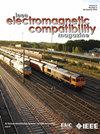Uncertainty Analysis of Geomagnetically Induced Currents in UHV Power Grid Based on Compressed Sensing Optimization
IF 2.5
3区 计算机科学
Q3 ENGINEERING, ELECTRICAL & ELECTRONIC
IEEE Transactions on Electromagnetic Compatibility
Pub Date : 2025-07-22
DOI:10.1109/TEMC.2025.3586319
引用次数: 0
Abstract
Geomagnetically induced currents (GICs) caused by geomagnetic storms pose a serious threat to the safe and stable operation of ultrahigh voltage (UHV) and extra-high voltage transmission systems. It is necessary to study the uncertainty of GICs affected by multidimensional input parameters to conduct a comprehensive assessment of the GICs levels in the power grid and their potential threats. The traditional polynomial chaos expansion (PCE) uncertainty analysis method incurs significantly higher computational cost in high-dimensional and high-order scenarios. Taking this into account, a PCE optimization method based on compressed sensing (CS) is proposed in this article. First, the Kriging method was employed to establish an earth conductivity model considering limited measurement data. Then, the proposed method was used to conduct the uncertainty analysis of GICs during storms in the North China UHV grid. The statistics of the maximum GICs in the North China power grid were obtained and compared with results from the Monte Carlo and PCE methods. Results indicate that the PCE method optimized by CS can efficiently analyze the uncertainty of GICs and substantially reduce the computational cost compared with the PCE method while ensuring accuracy. Finally, based on the total Sobol indices, the sensitivities of GICs to the input variables are analyzed to reasonably evaluate the threat of GICs to the power grid.基于压缩感知优化的特高压电网地磁感应电流不确定性分析
地磁暴引起的地磁感应电流对特高压、特高压输电系统的安全稳定运行构成严重威胁。研究受多维输入参数影响的GICs的不确定性,对电网中GICs的水平及其潜在威胁进行综合评估是必要的。传统的多项式混沌展开(PCE)不确定性分析方法在高维、高阶场景下的计算成本明显较高。考虑到这一点,本文提出了一种基于压缩感知的PCE优化方法。首先,考虑有限的测量数据,采用Kriging方法建立土壤电导率模型。然后,将该方法应用于华北特高压电网暴雨期间GICs的不确定性分析。对华北电网的最大GICs进行了统计,并与蒙特卡罗法和PCE法的结果进行了比较。结果表明,经CS优化的PCE方法在保证精度的前提下,能够有效地分析GICs的不确定性,大大降低了PCE方法的计算成本。最后,基于Sobol总指标,分析了GICs对输入变量的敏感性,合理评价了GICs对电网的威胁。
本文章由计算机程序翻译,如有差异,请以英文原文为准。
求助全文
约1分钟内获得全文
求助全文
来源期刊
CiteScore
4.80
自引率
19.00%
发文量
235
审稿时长
2.3 months
期刊介绍:
IEEE Transactions on Electromagnetic Compatibility publishes original and significant contributions related to all disciplines of electromagnetic compatibility (EMC) and relevant methods to predict, assess and prevent electromagnetic interference (EMI) and increase device/product immunity. The scope of the publication includes, but is not limited to Electromagnetic Environments; Interference Control; EMC and EMI Modeling; High Power Electromagnetics; EMC Standards, Methods of EMC Measurements; Computational Electromagnetics and Signal and Power Integrity, as applied or directly related to Electromagnetic Compatibility problems; Transmission Lines; Electrostatic Discharge and Lightning Effects; EMC in Wireless and Optical Technologies; EMC in Printed Circuit Board and System Design.

 求助内容:
求助内容: 应助结果提醒方式:
应助结果提醒方式:


